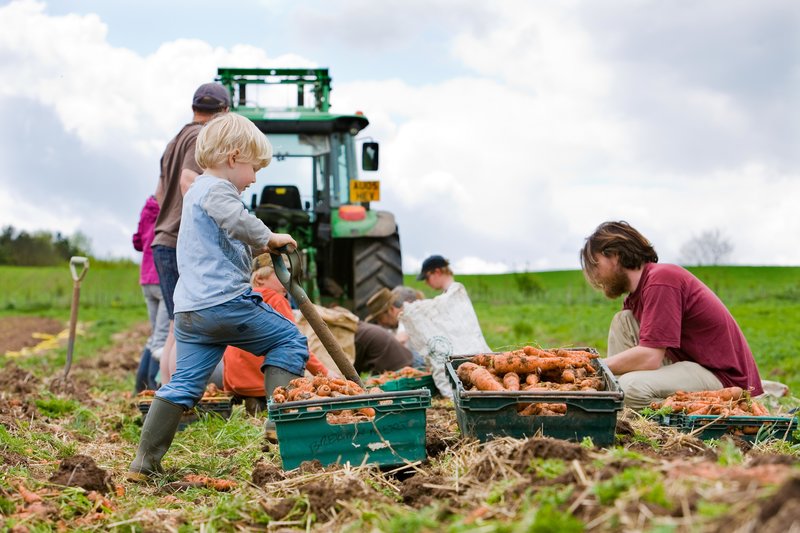Climate-Smart Rice Production Techniques
Climate-smart rice cultivation system shows promising results
Agriculture has always played a vital role in sustaining human life and providing food security. However, with the ever-changing climate patterns and the increasing global population, it has become crucial to adopt innovative approaches to ensure sustainable agricultural practices. In this regard, a climate-smart rice cultivation system has emerged as a promising solution.
The climate-smart rice cultivation system integrates various techniques and practices that not only enhance crop productivity but also contribute to climate change mitigation and adaptation. This system focuses on reducing greenhouse gas emissions, conserving water resources, and improving overall crop resilience. Let's delve deeper into the components and benefits of this innovative approach.
Component 1: Water Management
Water management plays a pivotal role in climate-smart rice cultivation. By employing techniques such as alternate wetting and drying (AWD), farmers can reduce water usage, thus conserving this precious resource. AWD involves periodically drying the rice fields, allowing the roots to breathe and adapt to changing water levels. This practice not only saves water but also reduces methane emissions from the rice fields.
A farmer practicing alternate wetting and drying (AWD) to conserve water
Component 2: Nutrient Management
Proper nutrient management is essential for maximizing crop yields and minimizing environmental impacts. The climate-smart rice cultivation system emphasizes the use of organic fertilizers, such as compost and biofertilizers, which enhance soil health and reduce the reliance on chemical fertilizers. This approach not only improves crop productivity but also reduces nutrient runoff, minimizing water pollution.
Component 3: Crop Selection and Rotation
Selecting the right rice varieties and implementing crop rotation strategies are crucial elements of the climate-smart cultivation system. By choosing climate-resilient rice varieties, farmers can ensure better adaptability to changing climatic conditions. Additionally, crop rotation with leguminous crops can improve soil fertility and reduce the incidence of pests and diseases, reducing the need for chemical pesticides.
Component 4: Conservation Agriculture
Conservation agriculture practices, such as minimum tillage and crop residue management, are integral components of the climate-smart rice cultivation system. Minimum tillage reduces soil erosion, increases soil organic matter content, and improves water infiltration capacity. Proper crop residue management not only enhances soil fertility but also sequesters carbon, contributing to climate change mitigation.
Component 5: Integrated Pest Management
Pests and diseases can significantly impact rice yields and quality. Integrated Pest Management (IPM) is an approach that focuses on using a combination of cultural, biological, and chemical control methods to manage pests effectively. By adopting IPM strategies, farmers can reduce pesticide use, minimize environmental pollution, and promote natural pest control mechanisms, such as beneficial insects.
Component 6: Climate Information and Advisory Services
Access to climate information and advisory services is crucial for informed decision-making in agriculture. The climate-smart rice cultivation system emphasizes the importance of providing farmers with real-time weather forecasts, climate risk assessments, and best management practices tailored to their specific regions. By leveraging climate information, farmers can better plan their cropping activities and mitigate risks associated with extreme weather events.
What is Climate-Smart Agriculture?
Climate-smart agriculture (CSA) refers to a holistic approach that aims to transform and reorient agricultural systems to effectively tackle climate change challenges. CSA comprises sustainable and climate-resilient practices, leveraging technology and innovation to enhance agricultural productivity, conserve natural resources, and reduce greenhouse gas emissions. The climate-smart rice cultivation system is one of the practical manifestations of CSA in the context of rice farming.
Ideas For Implementing Climate-Smart Rice Cultivation
The implementation of a climate-smart rice cultivation system requires a combination of individual farmer efforts, policy support, and institutional coordination. Here are some ideas for successfully implementing this innovative approach:
- Promote awareness and training: Conduct workshops, training sessions, and awareness campaigns to educate farmers about the benefits and techniques of climate-smart rice cultivation.
- Strengthen research and development: Invest in research to develop climate-resilient rice varieties and sustainable agricultural practices suitable for different agro-ecological regions.
- Encourage collaboration and knowledge sharing: Facilitate platforms for farmers, researchers, policymakers, and extension workers to exchange knowledge, experiences, and success stories related to climate-smart rice cultivation.
- Implement supportive policies: Governments should formulate policies that incentivize and promote the adoption of climate-smart practices, such as providing financial support, subsidies, and technical assistance to farmers.
- Ensure infrastructure development: Improve irrigation facilities, access to credit, and market linkages to enhance the productivity and profitability of climate-smart rice cultivation.
- Advocate for sustainable rice consumption: Raise awareness among consumers about the importance of sustainable and climate-smart rice production and encourage them to support farmers who practice these methods.
- Engage youth and women: Involve youth and women in climate-smart rice cultivation initiatives to ensure intergenerational knowledge transfer and inclusive agricultural development.
Recommendations for Scaling up Climate-Smart Rice Cultivation
To achieve widespread adoption and scale up climate-smart rice cultivation, it is essential to address various challenges and barriers. Here are some recommendations for scaling up this sustainable farming approach:
- Invest in infrastructure: Governments should invest in the development of irrigation systems, storage facilities, and transportation networks to support climate-smart rice cultivation.
- Build capacity: Provide farmers with technical training and capacity-building programs to enhance their understanding and implementation of climate-smart practices.
- Promote market linkages: Establish market linkages and ensure fair prices for climate-smart rice to incentivize farmers and create a sustainable value chain.
- Strengthen research and extension services: Enhance research and extension services to continuously develop and disseminate climate-smart technologies and practices.
- Enable access to finance: Facilitate access to affordable credit and financial instruments for farmers to invest in climate-smart technologies and inputs.
- Collaboration and partnerships: Encourage collaboration among governments, international organizations, research institutions, and private sector stakeholders to collectively address challenges and share best practices.
- Policy support: Governments should implement policies that promote climate-smart agriculture, including regulatory frameworks, subsidies, and incentives for farmers.
Listicle of Climate-Smart Rice Cultivation Practices
- Alternate wetting and drying (AWD) to conserve water
- Use of organic fertilizers, such as compost and biofertilizers
- Selection of climate-resilient rice varieties
- Crop rotation with leguminous crops
- Minimum tillage and crop residue management for soil conservation
- Integrated Pest Management (IPM) practices for pest control
- Access to climate information and advisory services for informed decision-making
- Collaboration and knowledge sharing among stakeholders
- Training and capacity-building programs for farmers
- Incentives and supportive policies from governments
Question & Answer
Q: How does climate-smart rice cultivation contribute to climate change mitigation?
A: Climate-smart rice cultivation reduces greenhouse gas emissions by adopting practices like alternate wetting and drying (AWD) and minimum tillage, which prevent the release of methane and sequester carbon in the soil.
Q: Can climate-smart rice cultivation improve water use efficiency?
A: Yes, climate-smart rice cultivation techniques, including AWD, help conserve water by reducing irrigation requirements and improving water use efficiency.
Q: Does the climate-smart rice cultivation system only benefit farmers?
A: No, the climate-smart rice cultivation system benefits not only farmers but also society as a whole. It promotes sustainable agricultural practices, reduces environmental pollution, enhances food security, and contributes to climate change adaptation and mitigation.
Summary of Climate-Smart Rice Cultivation
The climate-smart rice cultivation system offers a promising solution to the challenges posed by climate change and the need for sustainable agriculture. By incorporating water and nutrient management, crop selection and rotation, conservation agriculture, integrated pest management, and climate information services, farmers can enhance their productivity, adapt to changing climatic conditions, and contribute to climate change mitigation.
Implementing climate-smart rice cultivation requires the collective effort of farmers, governments, researchers, and other stakeholders. By raising awareness, providing financial and technical support, promoting collaboration, and enabling policy frameworks, we can scale up this innovative approach and ensure its widespread adoption. Let us embrace climate-smart rice cultivation for a resilient and sustainable future.




Post a Comment for "Climate-Smart Rice Production Techniques"